Maryland's Champion Tree Lives On:
The Legacy of the Old Wye Oak
By Ann E. Dorbin
From May 2003 to November 2004, Jim McMartin and Jim Beggins, partners in McMartin & Beggins Furniture Makers, painstakingly designed and hewed wood from the fallen Wye Oak into a desk that will serve the Governor's Office for many hundreds of years. The new desk is now part of the permanent collection of the Maryland State Archives Commission on Artistic Property, keeping alive the Wye Oak's heritage, a legacy that began more than 460 years ago.
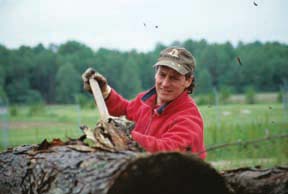 Perhaps more than any other accomplishment in its long, celebrated life, this majestic white oak of spectacular proportions - weighing 200 tons, 96 feet tall, with a crown spread of more than 119 feet, and 32-foot circumference (not including the great, gnarled "knees," scars left as reminders of a long-ago era when the iron-shod hooves of horses damaged the roots which gave it its massive base) - was a people's tree. Visitors traveled from far and wide to view its majesty and sit in the shade of its sweeping canopy. Perhaps more than any other accomplishment in its long, celebrated life, this majestic white oak of spectacular proportions - weighing 200 tons, 96 feet tall, with a crown spread of more than 119 feet, and 32-foot circumference (not including the great, gnarled "knees," scars left as reminders of a long-ago era when the iron-shod hooves of horses damaged the roots which gave it its massive base) - was a people's tree. Visitors traveled from far and wide to view its majesty and sit in the shade of its sweeping canopy.
It was among Maryland's greatest living symbols, and was older than the state itself (it was already 100 years old when the Ark and Dove landed at St. Clement's Island in 1634). Located in the village of Wye Mills in Talbot County, it had stood watch over almost five centuries, from a woodland trail used by the original North Americans to colonial expansion to modern day changes. In 1940, the Wye Oak was named by the conservation group American Forest as one of the original "Champion Trees." The White Oak species Quercus alba was declared the Maryland State Tree in 1941. (Contrary to popular thought, while the Wye Oak is the largest and most famous example of the species in Maryland, it is not the State Tree.) Upon its demise, natives and visitors alike felt the loss of the venerable tree.
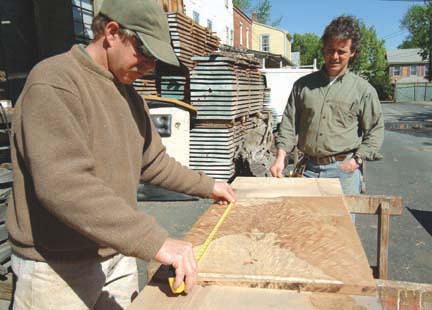 After its collapse, more than 80 tons of wood, including the bole (trunk), was immediately moved into storage in State facilities. Every effort was made to salvage as much of the tree material as possible and to keep whole pieces intact. The Departments of Natural Resources, Agriculture, and General Services worked together inventorying and storing the many pieces. After its collapse, more than 80 tons of wood, including the bole (trunk), was immediately moved into storage in State facilities. Every effort was made to salvage as much of the tree material as possible and to keep whole pieces intact. The Departments of Natural Resources, Agriculture, and General Services worked together inventorying and storing the many pieces.
To Jim McMartin and Jim Beggins, these remnants were precious bounty. Their renowned woodworking shop is located in the heart of St. Michaels, Maryland. Both Jims have a strong background in boat building, and the firm has been restoring antiques and constructing Federal-style furniture, built in a period manner, for two decades.
After receiving thousands of suggestions, the State recommended commissioning a governor's desk built from Wye Oak wood. Research by the staff of the State Archives, the lead agency in the project, had determined that the desk previously used in the Governor's Office was transient and had little historical or artistic significance. Speaking in the State House in Annapolis, State Archivist Edward C. Papenfuse, announced that, "The Committee felt that there could be no more fitting use for some of the wood than a legacy desk for the Governor, a place where many of the most important decisions affecting the lives of our citizens will be made. Such a desk would serve as a reminder to the governor of the milestones of good government that the life of the Wye Oak encompassed, not the least of which were those that took place in this very state."
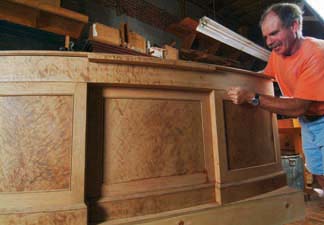 In May 2003, Governor Robert Ehrlich accepted a design and price proposal from McMartin & Beggins Furniture Makers to build a historically accurate desk for the Governor's Office. The $25,000 project was underwritten by Baltimore businessman and philanthropist, Henry A. Rosenberg, Jr. and his family. McMartin had designed a six-foot-wide, traditional pedestal desk with a sweeping curved bow front that emphasizes the natural beauty of the Wye Oak. The frame and panel configuration affords the use of broad, book-matched panels to effectively display the highly-figured grain of the old growth wood. In May 2003, Governor Robert Ehrlich accepted a design and price proposal from McMartin & Beggins Furniture Makers to build a historically accurate desk for the Governor's Office. The $25,000 project was underwritten by Baltimore businessman and philanthropist, Henry A. Rosenberg, Jr. and his family. McMartin had designed a six-foot-wide, traditional pedestal desk with a sweeping curved bow front that emphasizes the natural beauty of the Wye Oak. The frame and panel configuration affords the use of broad, book-matched panels to effectively display the highly-figured grain of the old growth wood.
McMartin and Beggins carefully selected logs characterized by soundness, striking grain, and figure. As the crew milled the ancient wood, vaguely familiar echoes from centuries past seemed to join the sounds of axes and chisels. A pinkish-orange haze of sawdust spewed into the drizzle as the Wood-Mizer saw sliced beautiful oak boards. The crew milled what would become the desk's veneer from the uppermost vertical section of the main trunk. Using a metal detector, crow bars, mallets, and chisels, they worked around large numbers of metal fittings and support cables.
The milled lumber was trucked to the St. Michaels workshop and stacked to "season" or air dry. After air drying for about ten months, it was transferred to a small dehumidification kiln for about a month to further reduce the moisture content. "You have to remember," Beggins points out, "that moisture content is not static. The wood will continue to acclimate to the environment. That's why construction techniques are so important. We put a great deal of thought into the structural aspects that allow for movement as the wood expands and contracts with seasonal changes."
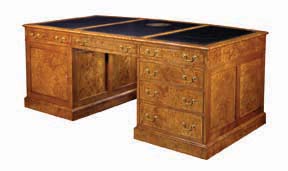 Next, they began the task of making sawn veneers. This was a crucial step because the veneers are the focal point of the desk. In June 2004, the assembly process began in earnest. During construction, McMartin and Beggins worked very closely with Mimi Calver and Elaine Rice Bachmann, curators for the Maryland Commission on Artistic Property. Next, they began the task of making sawn veneers. This was a crucial step because the veneers are the focal point of the desk. In June 2004, the assembly process began in earnest. During construction, McMartin and Beggins worked very closely with Mimi Calver and Elaine Rice Bachmann, curators for the Maryland Commission on Artistic Property.
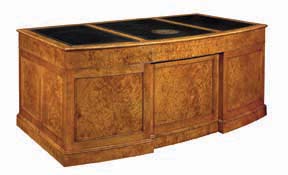 The first phase was to create the pedestals for the desk. Construction was performed using the 18th and 19th century techniques of mortise and tenon joinery and hand-cut dovetails, time-honored techniques that produce furniture that lasts hundreds of years. The Federal period (circa 1785-1810) rendered furniture that was distinctly American, yet still influenced by English design. "Generally speaking," McMartin explains, "period furniture was built with an exterior of more expensive, or rarefied wood, and the interior with something less expensive but still structurally sound." All of the primary (exposed) wood used for the Governor's desk is from the Wye Oak tree. Secondary wood (interior and structural) came from quarter-sawn Talbot County white oak trees. The first phase was to create the pedestals for the desk. Construction was performed using the 18th and 19th century techniques of mortise and tenon joinery and hand-cut dovetails, time-honored techniques that produce furniture that lasts hundreds of years. The Federal period (circa 1785-1810) rendered furniture that was distinctly American, yet still influenced by English design. "Generally speaking," McMartin explains, "period furniture was built with an exterior of more expensive, or rarefied wood, and the interior with something less expensive but still structurally sound." All of the primary (exposed) wood used for the Governor's desk is from the Wye Oak tree. Secondary wood (interior and structural) came from quarter-sawn Talbot County white oak trees.
As the weeks progressed, goaded by rustic hand tools, the shape of the desk emerged, phoenix-like, from piles of sawdust. Modern tools were used to adjust the thickness of rough wood, but the final texturing was done using the same tools a Federal craftsman would have used-hand planes and chisels, and handsaws for cutting the dovetails.
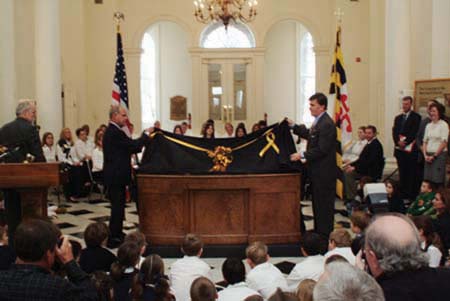 "Being antique restorers," says Beggins, who crafted the joinery on the piece, "we see why furniture that was built with proper construction techniques lasts for hundreds of years. Nowadays, very few people are building a desk like this out of solid wood. We occasionally use some modern glues, but otherwise we build exactly as they did in the period. All of the frame and panel joinery utilizes true mortise and tenon joints, with dovetailing on the drawers and case." "Being antique restorers," says Beggins, who crafted the joinery on the piece, "we see why furniture that was built with proper construction techniques lasts for hundreds of years. Nowadays, very few people are building a desk like this out of solid wood. We occasionally use some modern glues, but otherwise we build exactly as they did in the period. All of the frame and panel joinery utilizes true mortise and tenon joints, with dovetailing on the drawers and case."
"The dovetailing we do is not reproducible on a machine," McMartin adds. "I can't say it's structurally better than a machine-cut dovetail, but aesthetically, it wins hands down. The joinery work , done by hand, is virtually indistinguishable from what you would find in a piece that is 200 years old. It imparts an overall quality to the piece, a testimony to well-built furniture of the past."
The assembled desk was lightly stained to accentuate the grain, and then finished with shellac and paste wax. It has six working drawers, a cabinet, and a writing slide that protracts from the center front section. The top has three tooled sheep-hide leather writing surfaces framed in oak cross banding and a decorative, gold embossing of the Great Seal of Maryland. The central front panel of the desk is designed opens to a plaque engraved with an image of the Wye Oak. The names and administration dates of each governor who uses the desk will be added to the plaque over time. The heavy oak desk was designed to be easily dismantled into three parts.
On November 18, 2004, the Governor's Legacy Desk was officially unveiled in the rotunda of the State House. Later it was moved to the Governor's Office, where it will serve as the statesman's everyday work desk.
"We feel very fortunate to have been able to build this legacy desk for the State of Maryland; the historical aspects are very important," McMartin says of the finished project. "The fact that it was made from the Wye Oak is about as significant as can be for an official State desk. And to have the bonus of this incredible grain is the best any woodworker could hope for!"
It's possible the new Governor's Desk could last for a thousand years or more, almost certainly longer than the Wye Oak would have lived. It is a way for all Marylanders to share in celebrating this once magnificent tree. In a single glance, this masterpiece displays what took hundreds of years to grow. Quite aside from its physical beauty, the Wye Oak continues to live as a symbol of survival.
Jim McMartin and Jim Beggins,
McMartin & Beggins Furniture Makers
The Mill at East Chew Ave, 605 S. Talbot St.,
Unit 5, PO Box 1249, St. Michaels MD 21663
410-745-5715 (voice and fax)
mcbeg@goeaston.net
thefram@intercom.net
Mimi Calver, Maryland State Archives
Commission on Artistic Property
Director of Exhibits,
Outreach and Artistic Property
410-260-6444
mimic@mdsa.net
Henry A. Rosenberg, Jr.,
desk underwriter
410-347-7061 (contact: Jean Keenan)
Sources
Maryland State Archives. "The Wye Oak" Fact Sheet, dated May 2003.
Maryland State Archives. http://www.mdarchives.state.md.us/
Maryland Department of Natural Resources. "Wye Oak Advisory Committee Final Report," dated July 29, 2002.
Maryland Department of Natural Resources Forest Service. "The Quiet Giant, The Wye Oak." www.dnr.state.md.us/forests/trees/giant.html.
McMartin & Beggins Furniture Makers. Proposal Re: Governor's Desk Made from Wye Oak, dated April 25, 2003.
National Agricultural Library. Special Collections: "An American Champion: Maryland's Wye Oak."
Papenfuse, Edward C., State Archivist. "Announcement of the Wye Oak Legacy Desk for Governor of Maryland," dated May 15, 2003.
Preston, Dickson J. Wye Oak: The History of a Great Tree Cambridge, Maryland: Tidewater Publishers, 1972.
|
Back
|

